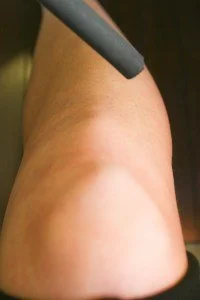Self-Care: Moxibustion!
A couple weeks ago, New Harmony hosted a free Medicine Cabinet Makeover class. There was plenty to gab, discuss and ponder, as we stood on the brink of cold and flu season. Now that the season is upon us, let’s consider another home remedy gifted by the ancient Chinese tradition – moxibustion.
The term “moxibustion” is a derivation of the Japanese “Moe Kusa,” which means, “burning herb.” We consider ourselves on a nickname basis with moxibustion, though, so you’ll often hear practitioners refer to it as “moxa.” Cute, right? While there are several different styles of moxa, they all consist of some form of a compressed herb – usually mugwort – that is lit and held over or on an area or point on the body. Before your imagination gets carried away, banish any image of a flaming torch. When lit, moxa burns similar to incense, with heat gently smoldering along the stick or cone. Depending on the technique employed, moxa has several applications:
1. Warm Channels and Dispel Cold Damp (Think along the lines of nagging joint pain that worsens during the winter.)
2. Induce smooth flow of Qi & Blood (Back to basics- cold contracts and slows, but heat expands and quickens, allowing the free flow of energy and blood to and through and area that requires healing. Mugwort is actually used internally as well to move the blood and promote healing.)
3. Strengthen Yang Qi (The benefits of raising the Yang energy are too numerous to list, but depending on the organ system involved will range from increasing sexual function to rectifying chronic loose stool.)
4. Add energy (While needles move and balance energy, moxa transfers new energy into the body.)
5. Prevent disease
For this DIY introduction, we’ll focus on the last action – disease prevention. The surest way to promote longevity and health is to support the strength of the Wei Qi. The Wei Qi is comparable to what we think of in our culture as the immune system. Traditional Chinese Medicine has realized for centuries that this energy is created by and dependent on the digestive energy – something that has just now come in vogue with the wave of probiotic popularity. The Wei Qi is created in our digestive center (the Spleen and Stomach meridians) and then transferred and stored in the Lung system, which is our most superficial organ system. Moxibustion a couple times per week on one or all of the points below will help your body’s defenses stay strong during the winter. Please see the precautions listed below before the protocol before starting your self-care program.
Hold Moxa Stick 1/2-to-1 inch from skin
You will need moxa sticks or stick-on cones, which you can purchase from your own local Traditional Chinese Medicine resource. A stick is large and cigar-like and can be snuffed out then used again as long as there is some left. There are also some smokeless varieties, for those who feel sensitive to the – shall we say – groovy, herbaceous odor of burning mugwort. As the stick burns down, you will need to tap the ash off into a tray, so as to avoid any ash falling on the skin. Once lit, hold the moxa stick ½ to 1 inch above each point in the protocol below. You want to feel warmth on the area, but not intense heat. As you feel heat intensity, pull the stick away completely from the skin then return it to a comfortable height above the point. Repeat for 5-10 minutes until the surface of the skin is slightly pink.
For stick-on cones, it is easiest to hold the cone in your hand while you light it then place the sticker-side on the point. Remove the cone as soon as you feel the point get warm, depositing it in a steel bowl or ashtray. Place another lit cone on the point and repeat the process for 5-10 minutes until the skin is slightly pink. The advantage of this form is that you can treat several points simultaneously; however, finding a comfortable position while you have burning cones sticking off your body can be an awkward maneuver!
Point protocol for strengthening the Wei Qi:
Moxa Cone at Stomach-36
Stomach 36 – Stomach 36 is on the lateral side of the tibia (shin bone), a hand’s-width below the crease at the knee. If you feel along the tibia, coming up from the foot, you’ll feel a notch below the kneecap. Just as you start to feel this notch, move your finger just lateral (toward the right on the right leg, toward the left on the left leg) to the bone, where you’ll feel a slight depression. Congratulations! You’ve found your first acupuncture point! Stomach 36 is called “Zu San Li,” which is translated as “Leg Three Miles.” Legend says that soldiers used to needle this point when fatigued so that they could make it three more miles.
Moxa Cone at Spleen-3
Spleen 3 – Feel on the inside of your foot, start at the front of thebig toe, then moving back toward the heel. Just behind the big toe joint, you’ll feel an obvious depression, and there lies Spleen 3, the tonification point on the Spleen meridian.
Ren 6 – About 2-finger widths below the umbilicus, on the midline of the torso, this point will help regulate Qi of Spleen and Stomach.




